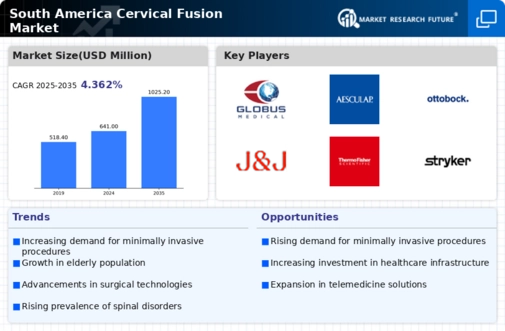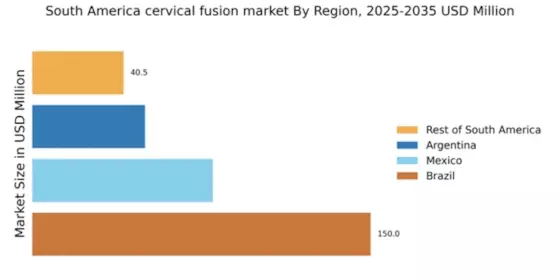Growing Aging Population
The demographic shift towards an aging population in South America is contributing to the growth of the cervical fusion market. Older adults are more susceptible to degenerative spinal conditions, necessitating surgical interventions such as cervical fusion. As the population aged 65 and above is expected to rise by 25% in the next decade, the demand for cervical fusion procedures is likely to increase correspondingly. The cervical fusion market must adapt to this demographic change by ensuring that healthcare systems are equipped to handle the anticipated surge in surgical cases, thereby driving market growth.
Rising Healthcare Expenditure
In South America, increasing healthcare expenditure is a crucial factor driving the cervical fusion market. Governments and private sectors are allocating more funds towards healthcare infrastructure, which includes spinal surgery facilities. This investment is likely to enhance the availability of cervical fusion procedures, making them more accessible to patients. The cervical fusion market is benefiting from this trend, as improved healthcare funding allows for better training of medical professionals and acquisition of advanced surgical tools. As a result, the market is projected to grow, with an estimated increase in spending on spinal surgeries by 20% over the next few years.
Advancements in Surgical Techniques
Innovations in surgical techniques are significantly influencing the cervical fusion market in South America. The introduction of robotic-assisted surgeries and enhanced imaging technologies has improved surgical outcomes and reduced recovery times. These advancements are attracting more patients to opt for surgical solutions over conservative treatments. The cervical fusion market is witnessing a shift as hospitals and clinics invest in state-of-the-art equipment to provide better care. As a result, the market is expected to expand, with a projected growth rate of around 15% annually over the next five years, driven by the adoption of these advanced surgical methods.
Enhanced Patient Awareness and Education
There is a notable increase in patient awareness regarding spinal health and available treatment options in South America. Educational campaigns and improved access to information are empowering patients to seek surgical solutions for cervical issues. This heightened awareness is driving demand for cervical fusion procedures, as individuals become more informed about their conditions and treatment possibilities. The cervical fusion market is responding to this trend by developing targeted marketing strategies to reach potential patients. As a result, the market is likely to experience growth, with an increase in patient inquiries and consultations for cervical fusion surgeries.
Increasing Prevalence of Cervical Disorders
The rising incidence of cervical disorders in South America is a primary driver for the cervical fusion market. Conditions such as cervical spondylosis and herniated discs are becoming more common, leading to a higher demand for surgical interventions. According to recent health statistics, approximately 30% of the adult population in certain South American countries experiences some form of cervical spine issues. This trend is likely to propel the need for cervical fusion procedures, as patients seek effective solutions to alleviate pain and restore mobility. The cervical fusion market is thus positioned to grow as healthcare providers respond to this increasing patient population requiring surgical treatment.


















Leave a Comment